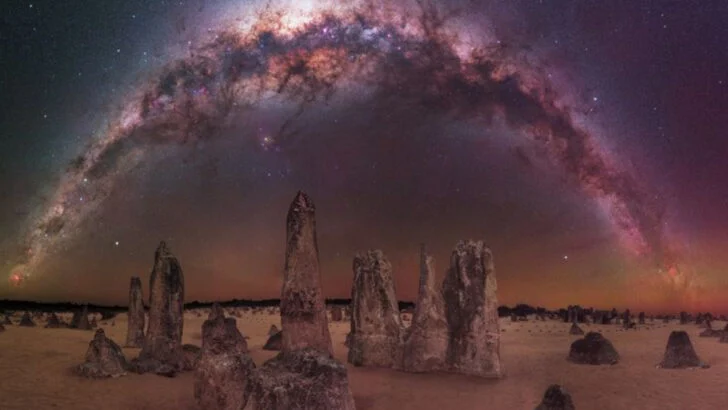Australia doesn’t just have unique wildlife—it has landscapes that feel like they’re from another planet. Deep in the outback, along the coast, and even hidden underground, nature has carved out places that defy explanation. These aren’t your typical postcard views—they’re bold, strange, and unforgettable. If you’re the kind of traveler who loves the unusual, Australia might just blow your mind.
Uluru (Ayers Rock), Northern Territory
Uluru looms large in the heart of Australia’s arid Red Centre, a sandstone monolith with a presence as sacred as it is monumental. The rock’s surface transforms under the sun, shifting from ochre to crimson, a spectacle that captivates all who behold it. At dawn and dusk, Uluru’s vibrant hues create a canvas of colors that defy the desert’s barren reputation.
This massive formation isn’t just a visual marvel; it’s a spiritual epicenter for the Anangu people, whose traditions and stories are etched into its very surface. Visitors feel its ancient pulse, a timeless connection to the land.
Did you know? Uluru’s formation began more than 500 million years ago, and today, it stands as a symbol of Australia’s natural and cultural heritage.
Great Barrier Reef, Queensland
Stretching over 2,300 kilometers along Australia’s northeast coast, the Great Barrier Reef is the planet’s largest coral reef system. Its vibrant underwater world boasts an array of neon-colored fish, intricate coral structures, and diverse marine life, creating an alien-like underwater sanctuary.
Snorkelers and divers find themselves in a world of wonder, where giant clams and turtles glide effortlessly through the limpid waters. The reef’s striking beauty is a reminder of the ocean’s fragile ecosystems and the urgent need to protect them.
Did you know? The Great Barrier Reef can be seen from space, a testament to its vastness and significance as a global treasure.
Lake Hillier, Western Australia
Imagine a lake so vividly pink that it seems to belong to another world. Lake Hillier, nestled on Middle Island off Western Australia’s coast, is exactly that—a strikingly pink body of water bordered by white salt and lush eucalyptus trees.
The lake’s unusual color is still a scientific mystery, though it’s believed to be caused by the presence of a particular type of algae. From the air, the contrast between the lake’s pink hue and the azure ocean is breathtaking.
Fun fact: Despite its unusual color, the water in Lake Hillier is safe to swim in, making it a unique swimming destination.
The Pinnacles Desert, Western Australia
In the heart of Nambung National Park lies a landscape that feels plucked from a science fiction novel. The Pinnacles Desert features thousands of limestone pillars rising from the golden sands, creating an eerie, alien-like terrain that fascinates visitors.
These formations, some standing several meters tall, were formed thousands of years ago from seashells. As the sun rises and sets, the desert glows in golden hues, providing a surreal backdrop for photographers and nature enthusiasts alike.
Did you know? The Pinnacles were formed over millions of years as the sea retreated, leaving behind ancient marine life remains that eventually became limestone.
Bungle Bungle Range, Purnululu National Park, WA
Hidden in the remote Kimberley region, the Bungle Bungle Range’s beehive-shaped domes are nature’s architectural marvels. These striped formations, with their distinct orange and black bands, create a mesmerizing pattern that seems almost artificial.
Carved by erosion over millions of years, these geological wonders are a testament to nature’s persistent artistry. The range’s remoteness adds to its mystical allure, attracting adventurers seeking to explore its intricate formations and hidden gorges.
Fun fact: The Bungle Bungle Range was relatively unknown to the outside world until the 1980s, making it a relatively recent discovery in modern times.
Horizontal Falls, Western Australia
Nature offers few spectacles as rare and thrilling as the Horizontal Falls. Located in the Kimberley region, these ‘falls’ are created by tidal currents squeezing through narrow coastal gorges, creating a horizontal waterfall effect.
Jet boat rides take thrill-seekers on an adrenaline-pumping journey through the rushing waters, an experience that feels like bending the fabric of time and space. The surrounding rugged landscapes add to the falls’ dramatic appeal.
Did you know? The Horizontal Falls are described by David Attenborough as “one of the greatest natural wonders of the world,” highlighting their global significance.
Glow Worm Caves, Springbrook National Park, Queensland
Step into a darkened cave and find yourself under a starlit ceiling, not from the sky, but from thousands of bioluminescent glow worms. The Glow Worm Caves in Springbrook National Park offer a magical experience, where blue-green lights create an ethereal atmosphere.
Visitors are transported into a realm that feels both mystical and otherworldly, with the glow worms’ soft illumination drawing gasps of wonder. The serene environment of the caves enhances the enchanting experience.
Fun fact: The glow worms are actually the larvae of a type of fungus gnat, and their light is used to attract prey.
MacKenzie Falls, Victoria
MacKenzie Falls stands as one of Victoria’s largest and most majestic waterfalls, where water cascades year-round over rugged cliffs into a deep, shadowy gorge. Unlike many waterfalls that dry up, its constant flow is a testament to its enduring grandeur.
The misty spray from the falls often produces rainbows, adding a touch of magic to the already dramatic setting. The surrounding basalt rocks enhance the sense of timelessness, making it a perfect retreat for nature lovers.
Did you know? The falls are named after Sir Alexander Mackenzie, a 19th-century explorer, although he never actually visited the falls himself.
Wave Rock, Western Australia
Nature’s sculptural masterpiece, Wave Rock rises 15 meters high, resembling an enormous wave about to crash onto the outback’s dusty floor. This granite formation was carved by natural forces over millions of years, resulting in its unique wave-like appearance.
The rock’s curves and colors are a photographer’s dream, drawing tourists to marvel at its artistry and climb its crest. Its isolated location adds to the wonder, making it a must-see for those exploring Australia’s hidden gems.
Did you know? The rock’s distinctive shape was formed by weathering and water erosion, processes that continue to shape the landscape today.
Kangaroo Island’s Remarkable Rocks, South Australia
Perched on a windswept cliff, the Remarkable Rocks on Kangaroo Island live up to their name with their surreal shapes and bold presence. The granite boulders, sculpted by wind and sea over millions of years, resemble abstract art installations.
Their location above the crashing surf enhances their dramatic appeal, creating a striking contrast between the rugged rocks and the ocean’s expanse. Every angle offers a new perspective, revealing the rocks’ enigmatic beauty.
Did you know? The Remarkable Rocks are a result of 500 million years of geological activity, including the heating and cooling of molten rock.
Daintree Rainforest, Queensland
The Daintree Rainforest is one of Earth’s oldest and most biodiverse rainforests, a lush expanse teeming with life and history. Towering ancient trees and dense canopies house unique wildlife, like the vibrant cassowary, a bird that seems plucked from prehistory.
Every visit is a journey through time, where nature’s resilience and beauty are on full display. The rainforest’s rich ecosystem is a living museum of flora and fauna found nowhere else on the planet.
Fun fact: The Daintree is home to plants that date back to the time of the dinosaurs, offering a rare glimpse into the planet’s distant past.
The Bay of Fires, Tasmania
The Bay of Fires in Tasmania is a place where colors collide in a breathtaking display. The vivid orange lichen-covered rocks contrast sharply with white sandy beaches and turquoise waters, creating a painterly seascape.
This coastal stretch is known for its spectacular beauty and tranquil atmosphere, inviting visitors to explore its unique rocky shores and hidden coves. Sunset bathes the bay in a warm glow, enhancing its already stunning palette.
Did you know? The Bay’s name comes from Captain Tobias Furneaux, who saw Aboriginal fires burning along the coast in 1773, not from the fiery orange rocks.
The Twelve Apostles, Victoria (Great Ocean Road)
Majestic and imposing, the Twelve Apostles stand as towering sentinels along Victoria’s Great Ocean Road. These limestone stacks rise from the tumultuous Southern Ocean, a testament to the relentless power of nature’s forces.
Their dramatic presence against the backdrop of crashing waves and moody skies creates a seascape of raw beauty and awe-inspiring grandeur. Each apostle tells a story of erosion and time, a natural spectacle that captivates all who visit.
Did you know? Despite their name, only eight of the original limestone stacks remain due to erosion, yet they continue to inspire visitors with their timeless beauty.
Wolfe Creek Crater, Western Australia
Wolfe Creek Crater is a geological wonder, a massive circular depression left by a meteorite impact over 300,000 years ago. Its imposing size and symmetry stand out starkly against the arid expanse of the Western Australian outback.
Visitors can walk along the crater’s rim, pondering the cosmic forces that shaped this ancient landscape. The crater’s isolated location enhances its otherworldly aura, drawing those intrigued by Earth’s extraterrestrial encounters.
Did you know? Wolfe Creek is the second largest meteorite crater in the world that is still visible, providing a glimpse into the dramatic events of our planet’s past.
Mount Gambier’s Blue Lake, South Australia
Each November, Mount Gambier’s Blue Lake undergoes a magical transformation, turning a vibrant cobalt blue. This volcanic crater lake captivates with its stunning hue, a phenomenon driven by seasonal changes in temperature and water chemistry.
Visitors marvel at the lake’s striking color, which appears almost otherworldly against the surrounding greenery and volcanic landscape. Its deep waters and steep cliffs add to the sense of mystery and intrigue.
Did you know? Despite its vivid color change, the exact science behind the Blue Lake’s transformation remains partially unexplained, adding to its allure as a natural wonder.

